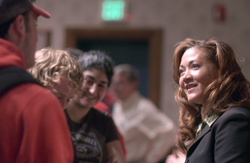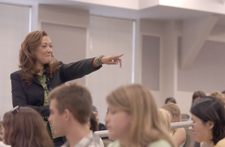Norris: Tools change, reporting basics do not
By Ben Weller

As a journalist who has worked for nearly two decades across the spectrum of print and broadcast news media, Michele Norris knows what technology has done to aid journalists. She has gone from using pay phones to call in stories to using cell phones, and from flipping through Rolodexes to find sources to using Google.
But all these advancements, says Norris, cannot become stand-ins for the real work of journalists. “The nuts and bolts of the process haven’t changed,” she said, just the tools. “We’re still required to ask sharp questions, to somehow record those answers.”
Over 400 people listened as Norris, co-host of National Public Radio’s All Things Considered, spoke of the advantages and risks of techno-journalism Monday night in Whittenberger Auditorium at the Indiana Memorial Union.
Local NPR affiliate WFIU co-sponsored her visit, and she led a roundtable discussion at Radio-TV earlier in the day. She also spoke to a journalism class at Ernie Pyle Hall.
She continued her theme during the evening talk. Internet search engines and wireless communications, said Norris, have become invaluable tools for journalists. She recounted tales from her work as an Los Angeles Times reporter of vying for pay phones with drug dealers while reporting on the drug wars in LA. In order to use a phone, she said, “I had to sweet talk my way into somebody’s house, explaining that I was a reporter for the Los Angeles Times.”

Reporters today, armed with satellite phones and Blackberries, may not face such dilemmas. “I speak to (NPR reporter) Ivan Watson in Afghanistan and he sounds more real, more present to me than the conversation I have with the academic in New Jersey,” said Norris.
But these technological advances present reporters and news audiences with a whole new set of problems. “There is a lot more information available to us right now,” she said, “but I’m not always convinced that we are better informed as a result.”
A major problem with these new technologies is that they allow reporters to stay in the newsroom rather than hitting the streets to find the real stories. “They lead,” she worries, “to a more sedentary form of journalism.”
The results can be disastrous for journalism and public awareness. The journalistic crimes of Jayson Blair and Stephen Glass were facilitated by their use of relatively simple technological tools that allowed them to pretend they were in places they were not. A real journalist, Norris cautioned, gets out of the newsroom and into the public sphere because “that’s where the news is.”

Norris is known among NPR listeners for her engaging and often hard-hitting interview techniques. No amount of technology, she said, can replicate the effect of sitting down in person for a one-on-one interview.
“The importance of body language and facial expression in interviews, that tells you something about the story,” she said. “We miss that when we’re always relying on
technology.”
For Norris, communication and information technologies present journalists and their audiences with useful tools and new challenges. The real dilemma may lie in what journalists and readers expect from the news.
“We can inform,” said Norris, “but our true goal is to enlighten.”

